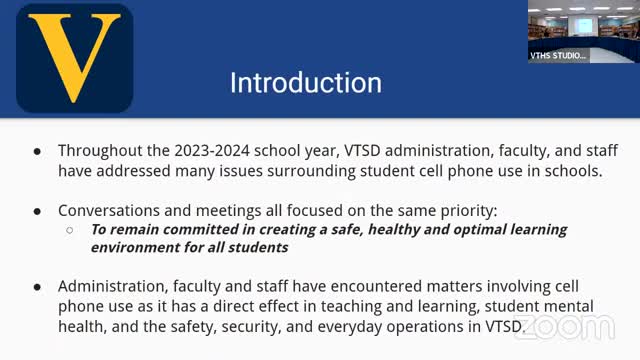Schools tackle cell phone crisis to boost student focus
August 23, 2024 | Vernon Township School District, School Districts, New Jersey
This article was created by AI summarizing key points discussed. AI makes mistakes, so for full details and context, please refer to the video of the full meeting. Please report any errors so we can fix them. Report an error »

In a recent school board meeting, administrators highlighted the growing concerns surrounding cell phone usage in classrooms, citing its detrimental effects on student mental health, academic performance, and overall classroom dynamics. Research presented during the meeting indicated a strong correlation between high screen time and increased levels of anxiety, depression, and behavioral issues among students.
The data revealed that students receive an average of 75 notifications on their phones during the school day, with some checking their devices up to 500 times daily. This constant distraction significantly hampers their ability to focus, with each notification reportedly taking about 20 minutes for students to regain their attention on lessons. Alarmingly, 94% of students admitted to using their phones for non-educational purposes during school hours, with 80% acknowledging that their academic performance has suffered as a result.
In response to these challenges, the board proposed a revision of Policy 5516, which would restrict cell phone use in schools. The new policy aims to foster a more conducive learning environment by encouraging students to store their phones in lockers during school hours. Administrators noted that schools that have implemented similar restrictions reported a 94% increase in student mental well-being, a 46% decrease in harassment and bullying incidents, and a 14% rise in test scores.
The meeting also emphasized the importance of collaboration with parents, teachers, and mental health organizations to address the issue comprehensively. Programs aimed at educating students about responsible technology use and enhancing family communication without screens have been initiated, reflecting a community-wide effort to tackle the pervasive influence of social media and cell phones on young people's lives.
As the school prepares for the upcoming academic year, the board is committed to creating a safe and focused learning environment, with plans for full implementation of the revised policy by September. The discussions have sparked a mix of support from parents and concern from students, indicating a significant shift in how schools are approaching technology in education.
The data revealed that students receive an average of 75 notifications on their phones during the school day, with some checking their devices up to 500 times daily. This constant distraction significantly hampers their ability to focus, with each notification reportedly taking about 20 minutes for students to regain their attention on lessons. Alarmingly, 94% of students admitted to using their phones for non-educational purposes during school hours, with 80% acknowledging that their academic performance has suffered as a result.
In response to these challenges, the board proposed a revision of Policy 5516, which would restrict cell phone use in schools. The new policy aims to foster a more conducive learning environment by encouraging students to store their phones in lockers during school hours. Administrators noted that schools that have implemented similar restrictions reported a 94% increase in student mental well-being, a 46% decrease in harassment and bullying incidents, and a 14% rise in test scores.
The meeting also emphasized the importance of collaboration with parents, teachers, and mental health organizations to address the issue comprehensively. Programs aimed at educating students about responsible technology use and enhancing family communication without screens have been initiated, reflecting a community-wide effort to tackle the pervasive influence of social media and cell phones on young people's lives.
As the school prepares for the upcoming academic year, the board is committed to creating a safe and focused learning environment, with plans for full implementation of the revised policy by September. The discussions have sparked a mix of support from parents and concern from students, indicating a significant shift in how schools are approaching technology in education.
View full meeting
This article is based on a recent meeting—watch the full video and explore the complete transcript for deeper insights into the discussion.
View full meeting
